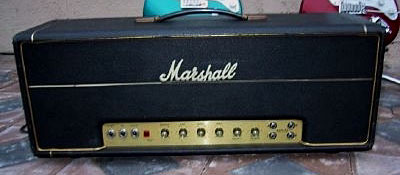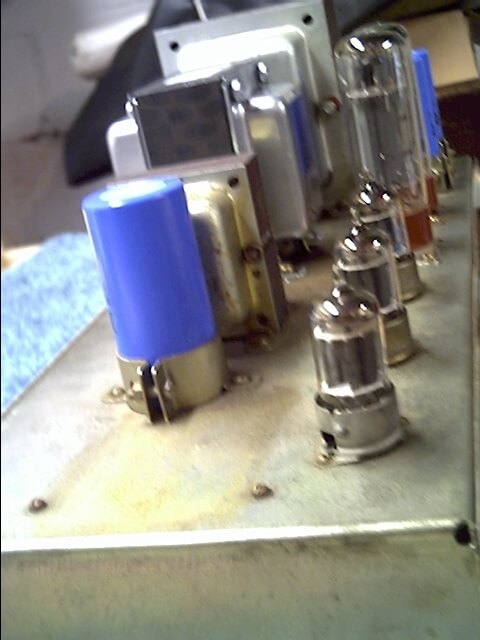
One of the common questions we receive here is, “How can I get my (fill in the blank with your favorite brand name) reissue amplifier to sound like the original?” Often times the question will contain additional information of what had been done already. “I’ve replaced the preamp and power tubes and gotten it biased, but it still sounds cold and brittle….”
My usual answer involves examining the guitarist’s rig by taking a “system” approach when looking for a particular tone. Often too much weight (i.e. blame!) is put on the amplifier, perhaps because it is the most electronically complex item in a typical signal chain. Countless times I’ve personally played with changes to an amplifier, whether modifying it, changing the tubes, etc. and still had poor results in overall tone! Now if you’ve got the wrong pickup or speakers for your needs, then obviously no change to an amp is going to help all that much….
But presuming all other areas of your guitar rig/system are covered, then let’s go back to the amp itself and talk about a particular upgrade that hasn’t gotten the attention it has deserved: the output transformer. In fact, dare I say that in many cases — for example a reissue amplifier — a change to a higher-quality output transformer will have a greater impact on improving the overall tone than playing with different brands of tubes. Essentially, if you’ve got the best tubes, or the worst tubes, but if your output transformer is a low-grade model, your tone will suffer no matter what you do.
“What the heck is the output transformer?,” you may ask. Well in layman’s terms, it’s the final connection in your tube amplifier that takes the signal from the tubes and transforms them into impedances and power suitable for your speakers. In further layman’s terms, it’s one of the big “metal blocks” that is attached to a typical tube amplifier’s chassis and is the connection link between your tubes and speakers. Most commonly, there are two large transformers in an amp — The other besides the output transformer is called the power transformer — that is the one that is responsible for taking the wall current and transforming it into the DC power used by your amplifier. While the power transformer is directly responsible for areas like supplying exactly how much voltage goes to your tubes and therefore can affect the response or “feel” of the amplifier, it is the output transformer that can dramatically affect the tone of your amplifier since audio signal is actually passing through it.
Like tubes, transformers can distort and color the sound, but in part because they are wired to an amplifier rather than just being “plug-in” devices, I feel they receive very little of the attention as to how much they can affect the tone. In fact, output transformers used to be thought of as simply items to be replaced when they failed. However, I can attest personally that in many instances a change in the output transformer to a quality unit as an upgrade can make a huge difference in tone — especially with those popular reissue Fender, Marshall, and Vox amps currently being made.
I recently was fortunate enough to try some units out made by Mercury Magnetics™ (www.MercuryMagnetics.com) with the idea being to install and listen to the various tones of some of their models of output transformers. The test-dummy amp used in the first case was a stock 1974 Marshall JMP 50 watt model 1987 Lead model — it had recently blown its output transformer after a tube had shorted a connection between two pins of the tube socket so it was the perfect candidate. The stock transformer still actually “worked” somewhat – but the power output was very low, probably about 1/5 of what the amp should have been producing.
 Mercury Magnetics™ offers three choices for replacement 50 watt output transformers and I had the opportunity to try two of them. The units are part of the Axiom® or ToneClone™ series which are hand-built replicas of the original transformers used in the Marshalls of various eras. In addition to the Marshall replacement transformers, Mercury Magnetics™ also makes various other Axiom® models for classic Vox and Fender amplifiers in addition to other toneful amps such as Ampeg, Gibson, Hiwatt, and many others.
Mercury Magnetics™ offers three choices for replacement 50 watt output transformers and I had the opportunity to try two of them. The units are part of the Axiom® or ToneClone™ series which are hand-built replicas of the original transformers used in the Marshalls of various eras. In addition to the Marshall replacement transformers, Mercury Magnetics™ also makes various other Axiom® models for classic Vox and Fender amplifiers in addition to other toneful amps such as Ampeg, Gibson, Hiwatt, and many others.
The models I tested were the Axiom® 050JM, a 50 watt output transformer model based on the earliest “plexi” Marshalls, and the Axiom® 050JM-SL, a similar model with the “Self-Leads” option. Both are priced at $150. The SL model differs from the standard 050JM in that it is made just like the earliest original plexi transformers were, where the solid copper core wire that is wrapped around inside the transformer continues outside of the transformer and is also the same wire used to connect to the tubes and impedance plug, etc. The solid-core copper SL wires outside of the transformer are covered by glass-cloth fabric material, just like that used on the original ‘60s models. Conventional transformers (including the non-SL version 050JM) use a different type of wire, often Teflon, that is spliced at the end of the solid-core wire that is then wrapped around the transformer inside. So what’s the big deal about the wire type? Oddly enough, it seems to really affect the tone of the output transformer — more on this in a moment.
Mercury Magnetics™ makes another model as well, the 050JM-M ($175), that is designed to be used in conjunction with modified Marshalls that require a beefier output transformer to better match up to the higher B+ plate voltages and other modifications or changes that run the amps harder. Since the ’74 JMP Marshall guinea pig was a stock model, I focused on the two plexi model variations, the 050JM and 050JM-SL.
The 050JM-SL was installed first. Since Marshalls sound best when run hard into power tube distortion, that’s exactly the listening environment I used. The head was run through a ’71 basketweave Marshall cabinet with G12M-25 greenbacks. The guitar was my trusty Les Paul Classic with a custom-specified Seymour Duncan Seth Lover PAF-type pickup. The tone of the amplifier with the 050JM-SL installed was brighter in the upper mids as well as the highs. The gain was a bit lower than with the stock Marshall’s output transformer (when it was properly functioning), but the clarity of notes and chords was definitely improved. The 050JM-SL is a good fit for players that like classic-rock and blues tones and perhaps need a bit more high-end cut through the mix. Usually additional highs are the last things that are needed with Marshalls, especially the amps and cabs made from about the mid ‘70s onwards. However, if you play through an earlier model Marshall loaded into a basketweave cab with G12-25s, “over brightness” really is not an issue and the O50JM-SL is the right match for this earliest type plexi tone. If you’re running a later checkerboard cab and a ‘70s JMP Marshall like our test model, the O50JM-SL may prove to have a bit more top end than what you’d want.
 Moving over to the O50JM, I was amazed at how different this transformer sounded, even though other than the lead wires that exited the transformer, it has the same specifications and parts as used in the O50JM-SL! After installing it, I knew that the O50JM was the choice for the hard-rockers, whether using a plexi or metal panel-front Marshall. The O50JM had more distortion dirt and grind in the tone. Both transformers contributed to a very smooth response from the Marshall, but the O50JM traded off the upper frequency and some of the clarity content found in the SL model for what sonically resulted to its increased distortion and compression.
Moving over to the O50JM, I was amazed at how different this transformer sounded, even though other than the lead wires that exited the transformer, it has the same specifications and parts as used in the O50JM-SL! After installing it, I knew that the O50JM was the choice for the hard-rockers, whether using a plexi or metal panel-front Marshall. The O50JM had more distortion dirt and grind in the tone. Both transformers contributed to a very smooth response from the Marshall, but the O50JM traded off the upper frequency and some of the clarity content found in the SL model for what sonically resulted to its increased distortion and compression.
I also had the opportunity to hear the difference in a 100 watt reissue Marshall SLP after a Mercury Magnetics™ O100JM ($250: their 100 watt “plexi” output model) was installed and the results were even more staggering than the difference between the stock and upgraded 1974 Marshall 50 watts. I attributed this directly to the obviously low-grade output transformer used in the reissue Marshall. Crank up a stock Marshall SLP reissue and the transformer really does mask the tone — bright, grainy and cold are the words that come to mind as well as a pure lack of fidelity. The O100JM brought back the low-end warmth, made the top end smooth and the famous Marshall midrange crunch was back in the equation just like the original models. This is tone, pure and simple — and the reissue SLP held its own against my original ’68 100 watt Plexi Marshall.
One area worth mentioning is that Mercury Magnetics™ can also rewind original vintage transformers if you don’t want to replace your burnt out original vintage transformer. Mercury Magnetics™ replaces the internal windings and necessary parts but uses the original core and covers and then puts the transformer back to original specifications. This is ideal for the person who is looking to maintain their amp in a form that is as original as possible. This service is more costly than simply replacing the output transformer outright, but it will also help maintain an amp’s value so it makes a viable choice.
When looking into swapping out an output transformer, while it’s not extremely complex to do, it’s best to have a qualified professional technician do the job as tube amps contain lethal voltages that are stored inside the amp even when it is not plugged in. It can be a bit of a time-consuming job as you have to get underneath the amplifier’s layout/circuit board so the average charge by a technician to remove and replace the old transformer with a new one will typically run about $100 or so.